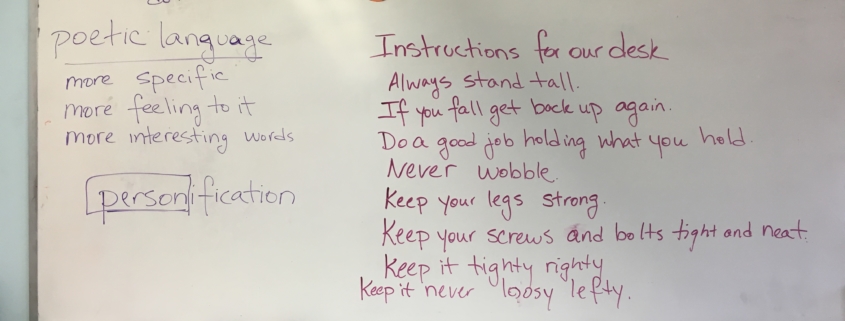School Visit: Haiku, Poetic Language, and Collaborative Writing
Last Friday I visited two elementary language arts classes at a local school in Washington, DC. I knew beforehand that the students had already done some work on haiku and had written winter animal haiku. I also knew that the teacher was hoping we could discuss poetic language and perhaps some other forms of poetry. With this in mind I planned our lesson.
We began with introductions. I said that I had heard they had been learning about haiku and asked them what they remembered learning. I said that I had also heard that they had been writing winter animal haiku and that I had brought my favorite winter animal haiku:
A bitter morning:
sparrows sitting together
without any necks
J. W. Hackett
Before I read it to them, I said that they could follow along while I read (I had it on a handout for them) or they could close their eyes while I read, if they liked. (When I have done this in the past, many students have said they really liked closing their eyes.) I read the poem slowly, twice. We talked about what bitter means, and I asked them what they noticed about the poem. One student asked why the sparrows didn’t have any necks. A few other students quickly hunched their shoulders to demonstrate. When I asked how they felt when I read the poem, some said cold.
Then, with heart-felt apologies to J. W. Hackett, I shared this with them (it was also on the handout):
A winter day:
birds sitting next to each other
hunching their shoulders
I said that I was trying to imagine what J. W. Hackett’s poem might have looked like when he first wrote it. (Again, my deepest apologies. Perhaps J. W. Hackett wrote truly impressive first drafts.) We then compared the two versions line by line and talked about how they were different. A student said that winter days can be warm or snowy or cold. We talked about how birds could mean any bird, but a sparrow is a specific little brown and gray bird. We talked about how the words bitter and sparrow are more interesting words than winter and bird. We talked about how the word “together” is more concise than “next to each other” and more emotional. For many of us “together” felt cozier and snugglier. We also talked about how the phrase “without any necks,” made us wonder what that meant, made us ask ourselves a question in our heads, and then think through the answer. Along the way the students noted that the syllable count in Hackett’s poem follows the 5/7/5 pattern and that mine does not. We clapped out syllables and talked about how some haiku follow the syllable pattern and some do not.
To pull it all together I said that J. W. Hackett’s haiku used more poetic language than my version. I wrote “Poetic Language” on the white board, and we made a list of what makes language more poetic. One student said, “This is like a list of what good poets do.” I quickly put that heading over mine. Underneath we wrote: “more specific, more feelings, and more interesting words.”
We then moved on to discussing another form of poetry, the “How to be…” or instruction poem. We read an instruction poem I had written, discussed it, identified any poetic language we could find, and then wrote a poem together. I chose the topic “Instructions for our Desks” before I arrived so we didn’t have to spend any time thinking about what to write about. My assumption was that everyone would have something to say about a desk and that it would be helpful to have the desks right in front of us. Before we started writing, we brainstormed using guiding questions:
What does our ideal desk look like?
What do we do at our desks?
What do we want our desks to do?
What do we hope our desks won’t do?
After a lively discussion, I wrote “Instructions for our Desks” on the white board and solicited lines from the class. The students seemed to have lots of ideas about what to add. I left them with the idea that what they might do next is look at the language in the poem and see where it might be even more poetic.
Overall, I would say the workshops went well and the kids were engaged. It was interesting to see how different parts of the plan engaged different kids. I think it worked well to compare versions with and without poetic language. I also think it worked well to brainstorm before writing together.
Next time, I will definitely ask one of the other adults in the room to signal me when there’s 10 minutes left. I find it very challenging to be engaged with the students while also keeping track of the time!
I welcome all thoughts about my lesson, sharing poetry in schools, and especially collaborative writing with students.
For more Poetry Friday, visit Tabatha Yeatts at The Opposite of Indifference.



For a moment there, that whiteboard and aqua wall projected me into a classroom I taught in! Even the date – though the order is a little jumbled. 😉 (We’d write day/date/month/year) Loved hearing about your school visit and can understand why you lost track of time. I’d call that a success – you and the kids are so engaged that time is forgotten.
Thank you! I know what you mean about the jumbled date. We lived in HK for a few years and now my kids are always asking what order to we do the date in again? I think your way makes more sense.
Love this, Liz! You really got to the heart of poetic language, and so quickly. Well done.
Thanks, Tabatha!
Liz, I enjoyed hearing about your lesson. I always tell teachers that the ending minutes of a lesson are key. I find that students need to reflect before leaving a lesson so that what was learned can be mulled over. I am sure that the students you worked with took away an awareness of poetic thought. I also liked the topic, Instructions for Our Desks.
Thanks, Carol. I really appreciate your advice about the last few minutes of a lesson. All the more reason to keep track of the time!
I love your comparison of Hackett’s haiku and your bland re-write. With just a few words, you gave them a very concrete example. (Yes, I’ll be borrowing this on Monday!)
Your comment about the time made me laugh out loud — timing is one of the hardest things about teaching!
Hurray! I am so happy you want to borrow!
Ah, this post makes me miss my teaching days! And I wish I had been in that classroom, too, being guided into poetry in this lovely way.
That feels awfully good coming from a master teacher like you. There were many days I wished I had been in your classroom.
Your examples of the two haiku seem just right for the students, & the listening & brainstorming, letting them have choice sounds like fun & productive, Liz. I smiled at that poem about the desk, concrete & fun, yes!
Thanks, Linda!
Lucky students! Thanks for sharing this sneak peek into your time with them, Liz. I totally understand the running-out-of-time part; while that usually means everyone is really engaged (wonderful!) I think Carol’s advice about giving them a few minutes to ponder new poetic principles is also worth noting. (Sometimes my school presentations tend to end in a frenzy, but with large groups where we can’t get quite as specific and interactive, that’s fun. In a classroom setting, though, it’s great that topics can be considered more deeply.) I love sharing strong haiku with kids. Love that sparrow imagery!
Yes, I totally agree. Carol’s advice is excellent! I love those neckless sparrows too.
I so appreciate how much time and attentiveness it must’ve taken to move through the lesson (and poem).
What an act of love….
I could feel the energy in your lesson from your blog post Liz–sounds like you really kept them engaged and vice-versa, thanks for sharing about it!
I wish I could have been there to watch this lesson. So perfect. Do you have any of the student work?